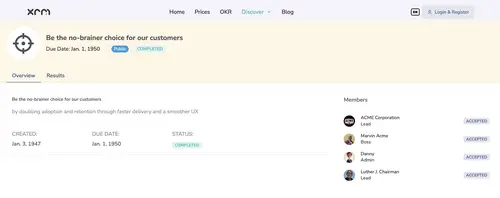OKR Example
OKR
OKR Example
for ACME Corp.

Contributor:
Сергей Владимирович Тихончук
17 hours ago
Step 1. Annual Strategic Session
Let's talk about the well-known ACME Corp. It didn't make headlines, but in September 1946, founder Marvin Acme gathered the Board of Directors for a strategic session. After heated debates (and possibly a few thrown anvils), they hammered out the company Vision: "Make meaningful outcomes so obvious and fast that even our dashboards keep up." The Mission followed: "Build only what solves real problems, prove it with numbers, and align every team so work beats talk."
The main objective for the next five years? "Be the no-brainer choice for our customers." Naturally, they set some Key Results:
- Double active customer adoption
- Lift gross retention to 110%
- Raise task-level UX satisfaction (CSAT) to 90%

Rumor has it they used a secret ENIAC clone running a pre-release version of XRM OKR software to track progress. Because why not?
They created the goal in the system and assigned roles:
- Marvin Acme – the Boss (approves goal statements and completion)
- Luther J. Chairman (ACME President) – the Lead (responsible for success)
- Danny (Luther's assistant) – Admin (does the actual work because vacuum-tube smartphones were a bit heavy, and Luther had "more important things to do" than stare at screens)
The entire company became Members of the goal. Now everyone could see The Goal and memorize it—no more claiming ignorance about what they're paid for.
But nothing moves without approval. Danny hit the Propose button, Marvin hit Approve, and boom—objective locked. No changes without Marvin's say-so. The same drill happens at year-end when Luther enters actual metrics and marks the goal Completed.
At this level, company-wide initiatives get planned. Initiatives are the change drivers aimed at objectives and influencing Key Results. Luther kicked off:
- Launch breakthrough explosive products line
- Perfect instant delivery system reliability
- Enhance catalog experience and accessibility
Step 2. Setting Annual Goals
Now it's the VPs' turn to dream big (or at least pretend to). VP Sales & Marketing Ms. Unfairly Promoted pitched Luther a vanilla "Dominate the market" objective. Luther loved it—after cranking up the Key Results, of course:
- Market share in desert regions: 95%
- Customer satisfaction rating: 9.5
- Annual revenue: $500M
Ms. Unfairly Promoted (or more likely, her assistant) created a sub-goal in the system: Luther as Boss, herself as Lead, and the VP Sales & Marketing department as Members.
Meanwhile, VP Research & Development Mr. Stating the Obvious discussed his sub-goal with Luther: "Achieve industry leadership in product UX." But Luther went full top-down on VP Operations Mr. Rhetorical Questions, and Danny dutifully created his sub-goal in the system.
VPs usually run cross-functional projects that roll up into longer programs and support their objectives.
Step 3. Setting Quarterly Goals
Some companies might stop at annual goals. Not Luther. He knew that between constant firefighting, 24/7 meetings, and never-ending "urgent" task lists, everyone would forget priorities until year-end panic set in. So he insisted on quarterly objectives for all departments.
VPs discussed and cascaded quarterly goals. For example, the Department of Direct Sales under Sales & Marketing got the objective: "Turn every coyote in the Southwest into a repeat customer."
- Mr. Nitpicking (Department Director) – Lead
- Ms. Unfairly Promoted (VP) – Boss
- His team – Members
At this level, department heads run local projects and improvements to hit their objectives.
Step 4. Regular Check-Ins
Check-ins are encouraged—but they shouldn't become yet another soul-crushing calendar placeholder. Usually, it's enough to remind everyone of objectives and review metrics during existing program or project status meetings. Keep it lean.
Step 5. Quarterly/Annual Grading and Reflection
At quarter's end, teams and individuals grade their Key Results. The scores are for learning and informing the next cycle—not for punishing underperformers (tempting as that may be).
Objectives can be adjusted based on data collected or new opportunities that pop up. Some companies link bonuses to OKR success, but that's widely considered a terrible idea—everyone just sandbags their goals to stay safe.
End of example. May your OKRs be ambitious and your anvils well-aimed.

- 07/30/2025
- 330
The OKR Edge: Radical Goals, Razor-Sharp Focus
OKR methodology is built to turn bold visions int…


- 12/04/2024
- 387
Russian Concepts of Dream and Destiny
If you have Russian colleagues or friends, you mi…